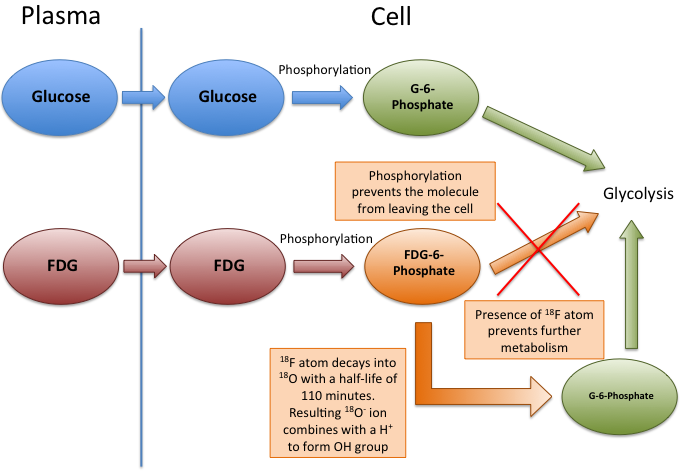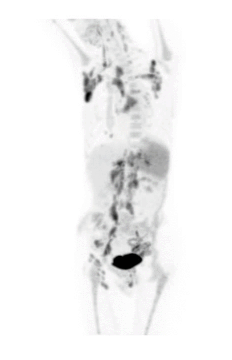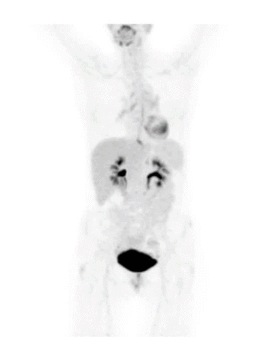Fluorodeoxyglucose
Glucose is a molecule essential for our bodies to function. Along with oxygen (O2), it is one of the reactants in respiration, the chemical reaction that takes place in our cells to give our bodies the energy they need.
Fluorodeoxyglucose (FDG) is a molecule of glucose where one of the hydroxyl groups (an oxygen atom bonded to a hydrogen atom) has been replaced with an atom of 18-fluorine.

Chemical structure of 2-deoxy-2-(18F)fluoro-D-glucose (FDG).
The only naturally occurring isotope of fluorine is 19F (i.e. atoms consisting of 9 protons and 10 neutrons). Other isotopes can be synthesized in a laboratory, however, and the one most useful for PET imaging is 18F (i.e. atoms consisting of 9 protons and 9 neutrons).
The 18F ions produced in the cyclotron undergo a series of chemical reactions in a hot cell that binds them with molecules called mannose triflates, which eventually results in molecules of 18FDG.
After emitting a proton, the atom’s atomic number drops by one, making it 18O, a stable, naturally occurring isotope of oxygen with two more neutrons than the more common 16O.
As the half-life of 18F is only 109.8 minutes, radiotracers containing this isotope must be either produced on-site, or delivered that day from an off-site laboratory.
Pharmacokinetics
FDG is normally injected intravenously. In the body, it is transported in the same way as normal glucose. As a result, it is taken into cells that have a high metabolic rate. Sites of disease in the body (including malignant tumours) normally have a high metabolic rate, and so FDG is taken preferentially into these areas. During uptake, patients lie still in a dark and quiet area, to reduce their metabolic rate and increase the ratio of uptake of FDG in sites of disease compared to healthy tissue.

Metabolic pathway of normal glucose (top) and FDG (bottom)
In theory, all of the FDG is taken up by cells in the body, and is trapped until emission of a positron takes place. In practice, about a fifth of the 18F is passed from the body through the urine via the kidneys.
Uses of FDG
FDG is used mostly for oncology, as it is preferentially taken up by tumours. It is the most commonly used radiotracer in PET imaging.
FDG Uptake
In an FDG scan, uptake is seen most in:
- The brain, as it is always metabolically active
- The bladder and kidneys, as some 18F is passed through the urine
- Sites of disease such as as infections, tumours etc usually have higher-than-normal metabolic rates

Pre-treatment FDG scan

Post-treatment FDG scan
